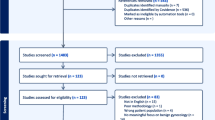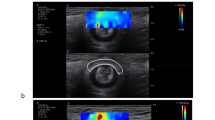Abstract
Introduction and hypothesis
Disorders of micturition result from a wide variety of conditions and evaluation often involves multiple diagnostic modalities. However, the sensitivity and specificity of these techniques are highly variable and may not always yield a diagnosis. Novel imaging techniques such as ultrasound shear wave elastography may help to improve diagnostic accuracy.
Methods
Continent women were recruited from outpatient gynecology offices from a tertiary medical system. Participants underwent ultrasound evaluation with measurement of the shear wave velocity (SWV) of the bladder neck (BN). SWV was used to determine the Young’s modulus of the bladder neck. The median bladder neck stiffness was calculated and univariate and step-wise and backward multivariate logistic regression analyses were used to identify significant patient characteristics associated with bladder neck stiffness above or below the median.
Results
Fifty-seven women underwent SWE of the bladder; 12 were excluded, and 45 were included in the analysis. The median bladder neck stiffness of the study population was 22 (17.1–28.2) kPa. Age greater than 45 years was associated with a bladder neck stiffness above the median, OR 8.39, p < 0.001. Having no vaginal deliveries was also associated with a bladder neck stiffness greater than 22 kPa, unadjusted OR 4.76 (95 % CI 1.41–20.0, p = 0.012). Bladder volume and bladder neck thickness were not significantly associated with bladder neck stiffness above or below the median.
Conclusion
Trans-abdominal shear wave elastography can be used to quantitatively assess bladder neck stiffness. This technique may potentially be useful for evaluating chronic urinary retention.


Similar content being viewed by others
References
Rees DL, Whitfield HN, Islam AK, Doyle PT, Mayo ME, Wickham JE. Urodynamic findings in adult females with frequency and dysuria. Br J Urol. 1975;47(7):853–60.
Griffiths DJ. The mechanics of the urethra and of micturition. Br J Urol. 1973;45(5):497–507.
Traube LE, Chaudhari V, Patel MK, Raman SS. Cross-sectional imaging of the female urethra. In: Cross-sectional imaging of the abdomen and pelvis. New York: Springer; 2015. p. 993–1021.
Chapple C, Sievert KD, MacDiarmid S, Khullar V, Radziszewski P, Nardo C, et al. OnabotulinumtoxinA 100 U significantly improves all idiopathic overactive bladder symptoms and quality of life in patients with overactive bladder and urinary incontinence: a randomised, double-blind, placebo-controlled trial. Eur Urol. 2013;64(2):249–56.
Avery JC, Stocks N. Urinary incontinence, depression and psychosocial factors—a review of population studies. EMJ. 2016;1(1):58–67
Elbadawi A, Yalla SV, Resnick NM. Structural basis of geriatric voiding dysfunction. IV. Bladder outlet obstruction. J Urol. 1993;150(5 Pt 2):1681–95.
Falconer C, Blomgren B, Johansson O, Ulmsten U, Malmström A, Westergren-Thorsson G, et al. Different organization of collagen fibrils in stress-incontinent women of fertile age. Acta Obstet Gynecol Scand. 1998;77(1):87–94.
Vereecken RL. A critical view on the value of urodynamics in non-neurogenic incontinence in women. Int Urogynecol J. 2000;11(3):188–95.
Lose G, Thyssen H. Reproducibility of cystometry and pressure-flow parameters in female patients. Neurourol Urodyn. 1996;15:302–3.
Versi E. Discriminant analysis of urethral pressure profilometry data for the diagnosis of genuine stress incontinence. BJOG. 1990;97(3):251–9.
Garra BS, Cespedes EI, Ophir J, Spratt SR, Zuurbier RA, Magnant CM, et al. Elastography of breast lesions: initial clinical results. Radiology. 1997;202(1):79–86.
Itoh A, Ueno E, Tohno E, Kamma H, Takahashi H, Shiina T, et al. Breast disease: clinical application of us elastography for diagnosis. Radiology. 2006;239(2):341–50.
Zhi H, Ou B, Luo BM, Feng X, Wen YL, Yang HY. Comparison of ultrasound elastography, mammography, and sonography in the diagnosis of solid breast lesions. J Ultrasound Med. 2007;26(6):807–15.
Sandrin L, Fourquet B, Hasquenoph JM, Yon S, Fournier C, Mal F, et al. Transient elastography: a new noninvasive method for assessment of hepatic fibrosis. Ultrasound Med Biol. 2003;29(12):1705–13.
Von Elm E, Altman DG, Egger M, Pocock SJ, Gøtzsche PC, Vandenbroucke JP. Strobe initiative. The strengthening the reporting of observational studies in epidemiology (STROBE) statement: guidelines for reporting observational studies. Prev Med. 2007;45(4):247–51.
Hvarness H, Skjoldbye B, Jakobsen H. Urinary bladder volume measurements: comparison of three ultrasound calculation methods. Scand J Urol Nephrol. 2002;36(3):177–81.
Tzankoff SP, Norris AH. Effect of muscle mass decrease on age-related BMR changes. J Appl Physiol. 1977;43(6):1001–6.
Jensen JK, Nielsen Jr FR, Ostergard DR. The role of patient history in the diagnosis of urinary incontinence. Obstet Gynecol. 1994;83:904.
Glazener C, Lapitan MC. Urodynamic investigations for management of urinary incontinence in children and adults. Cochrane Database Syst Rev. 2002. DOI: 10.1002/14651858.CD003195
Taylor LS. Three-dimensional sonoelastography: principles and practices with application to tumor visualization and volume estimation. 2002. Rochester, NY: University of Rochester. Department of Electrical and Computer Engineering
Nightingale K, McAleavey S, Trahey G. Shear-wave generation using acoustic radiation force: in vivo and ex vivo results. Ultrasound Med Biol. 2003;29(12):1715–23.
Yamaguchi T. The quantitative ultrasound diagnosis of liver fibrosis using statistical analysis of the echo envelope. In: Quantitative ultrasound in soft tissues. Netherlands: Springer; 2013. p. 275–28.
Yoon JH, Kim MH, Kim EK, Moon HJ, Kwak JY, Kim MJ. Interobserver variability of ultrasound elastography: how it affects the diagnosis of breast lesions. Am J Roentgenol. 2011;196(3):730–6.
Morikawa H. Real-time tissue elastography and transient elastography for evaluation of hepatic fibrosis. Rijeka: INTECH Open Access Publisher; 2012.
Salomon G, Köllerman J, Thederan I, Chun FK, Budäus L, Schlomm T, et al. Evaluation of prostate cancer detection with ultrasound real-time elastography: a comparison with step section pathological analysis after radical prostatectomy. Eur Urol. 2008;54(6):1354–62.
Ying H, Da L, Luo J, Li-Xia L, Yu X, Li-Mei X, et al. Quantitative assessment of bladder neck compliance by using transvaginal real-time elastography of women. Ultrasound Med Biol. 2013;39(10):1727–34.
Hall TJ, Zhu Y, Spalding CS. In vivo real-time freehand palpation imaging. Ultrasound Med Biol. 2003;29(3):427–35.
Bruschini H, Simonetti R, Antunes AA, Srougi M. Urinary incontinence following surgery for BPH: the role of aging on the incidence of bladder dysfunction. Int Braz J Urol. 2011;37(3):380–7.
Meyer S, Schreyer A, De Grandi P, Hohlfeld P. The effects of birth on urinary continence mechanisms and other pelvic-floor characteristics. Obstet Gynecol. 1998;92(4, Part 1):613–8.
Author information
Authors and Affiliations
Corresponding author
Ethics declarations
Conflicts of interest
None.
Rights and permissions
About this article
Cite this article
Sheyn, D., Ahmed, Y., Azar, N. et al. Trans-abdominal ultrasound shear wave elastographyfor quantitative assessment of female bladder neck elasticity. Int Urogynecol J 28, 763–768 (2017). https://doi.org/10.1007/s00192-016-3193-3
Received:
Accepted:
Published:
Issue Date:
DOI: https://doi.org/10.1007/s00192-016-3193-3




